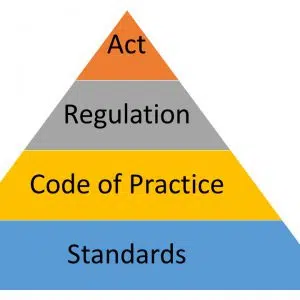Trying to read and understand legislation and codes of practice can be confusing if you don’t understand the hierarchy. This following fact sheet provides some guidance to understand the levels.
Act of Parliament
An act of law is made by Parliament. An Act is a statute or law passed by both Houses of Parliament that has received Royal Assent. On Royal Assent, Acts are given a year and number. Once an Act is formally enacted it can generally only be amended or repealed by another Act. When an Act changes, a compilation of the Act is prepared to show the Act as amended. Acts can also be known as primary legislation. The act provides the skeleton for legislation and is not frequently changed. [1]
Regulation, Rules or Codes
Are commonly known as “subsidiary legislation” and require publishing in the Government Gazette to become legal. These are the guidelines that dictate how the provisions of the Act are applied. They may also contain pro forma official forms that are required under the Act. Regulations and schedules to Acts can only be amended by a notice published in the Government Gazette. [2]
In short, a regulation provides additional guidance on the application of an act of parliament.
Case law
Over hundreds of years, judges have been deciding cases. Their decisions have developed a body of legal principles known as ‘common law’ or ‘case law’ that is declared by judges.
When a case comes before a court, the parties to the action present the evidence they need to support their case. The judge listens to the evidence, decides what evidence is relevant and what facts have been proved, decides what law is relevant, and applies that law to the facts in making a decision which is binding on the parties. Case law provides commentary on the decision of the courts and their interpretation. [3]
Codes of practice
A code of practice (COPs) is a set of guidelines for fair practice developed for a specific industry or occupation. COPs may be voluntary or statutory.[4]
Codes of practice may be used in court proceedings to provide guide decisions and interpretation.
In the example of work health and safety, courts may regard a code of practice as evidence of what is known about a hazard, risk or control, and rely on it to determine what is ‘reasonably practicable’ in the circumstances to which the code relates.
It is recognised that equivalent or better ways of achieving the required work health and safety outcomes may be possible. For that reason, compliance with codes of practice is not mandatory providing that any other method used provides an equivalent or higher standard of work health and safety than suggested by the code of practice.[5]
Codes of practice give more detailed advice about how employers can meet the requirements of the regulations. COPs do not replace the laws, but codes of practice can be issued to help make understanding of what you must do a little easier. Codes of practice are not legislation, but they give practical guidance on ways to comply with the Acts and regulations.
Health and safety representatives and Work Safe field officers (inspectors) can use the codes to suggest ways of remedying health and safety risks in the workplace. They can also use the codes as evidence when Acts or regulations have not been complied with.
Codes of practice can also provide a performance measurement for people in the workplace to follow. Some example codes of practice include:
- Codes of Practice for First Aid in the Workplace
- Codes of Practice for Manual Handling
- Codes of Practice for Noise
- Codes of Practice for Provision of Occupational Health and Safety Information in Languages Other than English
- Cash in Transit Code of Practice
Standards
Standards are voluntary documents that set out specifications, procedures and guidelines that aim to ensure products, services, and systems are safe, consistent, and reliable.
They cover a variety of subjects, including consumer products and services, the environment, construction, energy and water utilities, and more.
To ensure they keep pace with new technologies, standards are regularly reviewed by Standards Australia technical committees.
There are three categories of standards:
International Standards
These are developed by ISO, IEC, and ITU for countries to adopt for national use. Standards Australia embraces the development and adoption of international standards.
Examples of International Standards are:
- ISO 9001:2015 – Quality Management Systems
- ISO 14001:2015 – Environmental Management System
Regional Standards
These are prepared by a specific region, such as the European Union’s EN standards, or joint Australian/New Zealand standards.
Examples of Australian Standard include:
- AS /NZS 4801:2001 Occupational health and safety management systems— Specification with guidance for use
- AS/NZS 3760:2010: In-service safety inspection and testing of electrical equipment
National Standards
These are developed either by a national standards body (like Standards Australia) or other accredited bodies. Any standards developed under the Australian Standard® name have been created in Australia or are adoptions of international or other standards.
Examples of Australian Standard include:
- AS 3745: 2010 Planning for Emergencies in Facilities
- AS 1428, Design for access and mobility
Standards and the Law
On their own, standards are voluntary. There is no requirement for the public to comply with standards. However, State and Commonwealth governments often refer to Australian Standards® (AS) or joint Australian/New Zealand Standards (AS/NZS) in their legislation.
When this happens, these standards can become mandatory.[6]
[1] https://www.legislation.gov.au/content/WhatIsIt#targetText=An%20Act%20is%20a%20statute,or%20repealed%20by%20another%20Act.&targetText=Acts%20are%20also%20known%20as%20primary%20legislation.
[2] https://www.slp.wa.gov.au/faq.nsf/Web/Topics/C39627DF9C3527E348256CA8000DCBE5?opendocument
[3] https://lawhandbook.sa.gov.au/ch27s02s01.php
[4]https://lawhandbook.sa.gov.au/go01.php>
[5] https://www.safework.nsw.gov.au/resource-library/list-of-all-codes-of-practice
[6] https://www.standards.org.au/standards-development/what-is-standard
